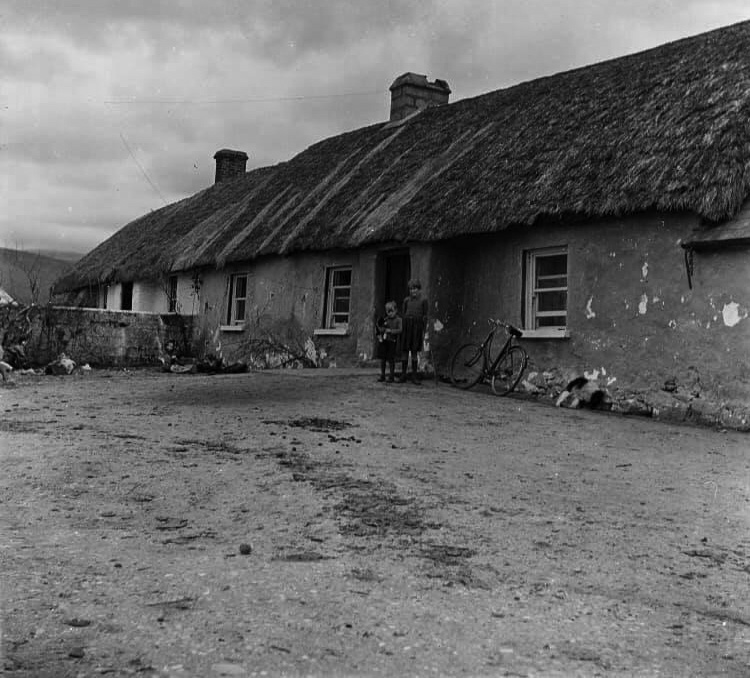
Saturday July 12 was the hottest day of 2025 in Ireland, when Oak Park in Carlow saw temperatures hit 30.1 degrees Celsius, and Mullingar in Co Westmeath and Shannon Airport both hit 30 degrees. Tempeatures in excess of 30 degrees are unusual enough in Ireland to have created a narrative of their own.
Verifiable records are sparse prior to the 1940s, and there is no Irish equivalent of Gordon Marley’s Central England Temperature dataset which intriguingly records England’s hottest summers as 1676, 1726, 1776, 1781, 1826 1876, 1926 and 1976.
Here are some of the best-remembered or recounted heat waves.
1765: The year the Liffey dried up
There are no useful temperature or rainfall records to help us make any comparison, but contemporary accounts reveal that 1765 was the year the Liffey dried up. In the summer of 1765 the Liffey dried up. Faulkner’s Dublin Journal reports on August 17 1765 that “this hath been the driest summer ever known in this kingdom, insomuch that the bed of the fine river, the Shannon, was dry at the Athlone bridge.” The Public Advertiser observed on 17 August 1765 from Waterford that ‘such dry weather was never known in those parts; everything burned up; the cows give no milk” and that “the mountain of Braudore is on fire, as is, likewise, a turf-bog in the County of Wexford “there is no possibility of approaching either to extinguish them.” Dublin doctor, John Rutty, wrote “the extreme drought of summer was such that some trees dropped their leaves for want of moisture, and the cattle wanted grass to supply milk and butter for the poor; and what added to the distress of these, the potatoes were scarce, and small; also there were very few apples, and the hay was scarce.’ Even eighty years later it was recalled by Oscar Wilde’s historian father, William, in 1851 that this was a “very dry summer, with parching northeast winds. The summer was followed by 14 drought periods of lesser intensity.
1859: Limited Records, Significant Heat
While poorly documented by modern standard, anecdotal evidence suggests temperatures likely reached the high 20s in the summer of 1859, causing discomfort in a society unaccustomed to prolonged heat. Agricultural output suffered due to drought-like conditions, impacting rural livelihoods. Communities relied on manual water collection, exacerbating the strain on daily life.
1887: Record-Breaking Heat at Kilkenny
In the summer of 1887, Ireland experienced its hottest day on record when temperatures soared to 33.3°C at Kilkenny Castle on 26 June, coupled with the driest year ever recorded at Glasnevin, Dublin (356.6 mm of rainfall). This strained water supplies and agriculture. Rural communities faced crop failures, while urban areas like Dublin grappled with water shortages, forcing residents to adapt to a parched landscape.
1911: Sweltering Summer Across the Isles
In 1911, temperatures approached 30°C, though specific Irish records are sparse. The heatwave, peaking at 36.7°C in England, strained Ireland’s agrarian society. Livestock losses mounted, and water scarcity disrupted farming. Urban centres saw increased demand for public fountains as residents sought relief.
1921: Eastern Canada’s Heat Echoes in Ireland
The summer of 1921 brought unusually warm conditions to Ireland, with temperatures estimated in the high 20s to low 30s, aligning with a scorching July across Eastern Canada and western Europe. The Central England Temperature hit 18.5°C, the warmest since 1852. In Ireland, the heat disrupted farming cycles, with reduced crop yields and stressed livestock. Rural communities adapted by prioritising water for essential use, while urban areas saw a surge in outdoor gatherings as people sought cooler evening air.
1934: Warm Spell Amid Global Extremes
Ireland’s 1934 heatwave saw temperatures likely reaching the high 20s, in a global context that included California’s record 57°C at Death Valley. The heat compounded challenges for farmers during the economic war, In effect a blockade of Ireland’s agricultural exports by the English, with reduced water availability impacting crops and livestock. Urban residents flocked to coastal areas for relief, boosting local economies but straining resources. Society adapted by embracing lighter clothing and adjusting work hours to avoid peak heat.
1947: Extreme cold to extreme heat
Shannon Airport recorded seven consecutive days having a maximum of at least 25°C or above in August 1947. It was exceptionally dry with it being the second driest of the century behind only 1995 and not surprisingly, very sunny too. The year 1947 had already coughed up record low temperatures and rainfall in February and March, blizzards, severe cold, floods and a heatwave. Peak temperature at Dublin airport was on August 16th 1947 at 29.2°C.
1976: A Historic Heatwave and Drought
The 1976 heatwave was a defining moment, with temperatures peaking at 32.5°C in Boora, Co. Offaly, on 29 June, marking the hottest June day in Ireland’s 20th-century records. Boora had a mean temperature of 29.4°C from 27 June to 5 July 1976 reaching 30°C on an unprecedented five consecutive days from 29 June to 3 July. The three-month drought, the worst in 150 years, led to water rationing and reservoir depletion. At Poulaphouca reservoir, submerged village of Ballinahown, including the graveyard, re-merged due to falling water levels. The heat contributed to mortality displacement, particularly among the elderly, and strained healthcare systems. Wildlife and vegetation suffered, with societal habits shifting towards water conservation and outdoor living, as people installed shutters and sought shade. Birr and Ballybrittas recorded 14 consecutive days of heatwave (with a maximum temperature of 25.0°C or greater) from 14 to 27 August 1976.
1983: A Scorching July with Lasting Impacts
July 1983 saw Ireland endure a significant heatwave, with temperatures reaching the high 20s to low 30s, contributing to 115 excess deaths in rural areas. The heat strained healthcare systems, particularly for cardiovascular and respiratory issues among the elderly. Water shortages prompted conservation measures, and farmers faced reduced yields. Urban areas adapted with increased use of public cooling spaces, while the heatwave’s severity underscored the need for better preparedness.
1989: Late Summer Heat Surge
In 1989, Ireland experienced a heatwave with temperatures climbing to around 30°C, a rare occurrence for the late summer. The heat disrupted daily routines, with schools and workplaces adjusting schedules to cope. Agricultural sectors faced challenges from prolonged dry spells, impacting crop production. Urban residents sought relief in parks and coastal areas, boosting local tourism but straining water supplies. The heatwave highlighted Ireland’s limited infrastructure for extreme heat at the time.
1990: Dublin’s hottest day
On August 2nd 1990, 30.6c was recorded at the Ordnance Survey office in Phoenix Park, , the highest recorded there since its records began in 1881. Casement Aerodrome got up to 29.5c, the hottest August day since 1975 and Dublin Airport got up to 28.7c, its hottest day on record. Dublin Airport’s temperature here was more than a degree higher than its previous record of 27.6c on 13th July 1983
1995: Record-Breaking Dryness and Heat
The summer of 1995 was Ireland’s driest on record, with temperatures reaching the high 20s to low 30s, contributing to 37 excess deaths. The prolonged heat and drought strained water resources, leading to restrictions and public awareness campaigns. Agriculture suffered, with reduced crop yields affecting rural economies. Urban areas saw increased demand for cooling, with shops selling out of fans. The heatwave prompted discussions on improving water management and heat preparedness.
2006: Modern Heat with Minimal Mortality
In 2006, Ireland faced a heatwave with temperatures peaking at 32.3°C in Elphin, Co. Roscommon, on 19 July. Despite the intensity, only 14 excess deaths were recorded, reflecting improved societal resilience. Water shortages persisted, but modern infrastructure mitigated some impacts. Farmers adapted with irrigation, while urban areas saw a boom in outdoor dining and beach visits..
2013: Prolonged July Heatwave
The 2013 heatwave saw temperatures reach 31°C in Ireland, part of a 19-day hot spell across insular Europe. The prolonged high pressure system strained water supplies, with farmers facing irrigation challenges. Urban areas adapted with increased use of air conditioning, while coastal tourism surged. The heatwave was the longest since 1997.
2018: Sizzling Summer with Societal Shifts
In 2018, Ireland endured a heatwave with temperatures hitting the high 20s to low 30s, exacerbating drought conditions. The heat strained water supplies, leading to hosepipe bans and conservation measures. Agriculture faced significant losses, particularly in potato and dairy sectors. Urban residents flocked to beaches, boosting coastal economies, while public health warnings targeted the elderly. The record for the longest heatwave in Ireland (with a maximum temperature of 25.0C or greater) is 18 consecutive days at Kilkenny from 24 June to 11 July 2018.
2021: Record-Breaking Heat in July
The 2021 heatwave saw temperatures reach 29.5°C in Athenry, Co. Galway, on 17 July, with a peak of 33.0°C at Phoenix Park, Dublin, on 18 July, the hottest since 1887. Met Éireann issued its first Status Orange high-temperature warning for six counties. Water shortages and increased wildfire risks prompted public restrictions. Society adapted with cooling centres and health advisories, while tourism to coastal areas surged.




